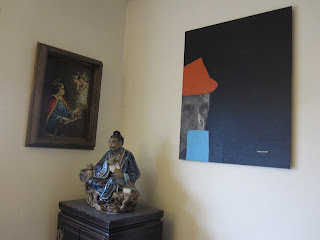Greenaway is considerably more interesting as a lecturer than I would have anticipated he would be.
Wednesday, December 29, 2010
Sunday, November 21, 2010
The Freight Train of History
VOLTAIRE, political philosopher (1694-1778)

CABARET VOLTAIRE, club in Zurich, birthplace of DADA (1916)

CABARET VOLTAIRE, seminal industrial band (1973-1994)

additional resources:
Cabaret Voltaire, the band
cabaret voltaire and more about dada

"So long as the people do not care to exercise their freedom, those who wish to tyrannize will do so; for tyrants are active and ardent, and will devote themselves in the name of any number of gods, religious and otherwise, to put shackles upon sleeping men"
“No snowflake in an avalanche ever feels responsible.”
"Life is a shipwreck, but we must not forget to sing in the lifeboats."
CABARET VOLTAIRE, club in Zurich, birthplace of DADA (1916)

“The symbolic view of things is a consequence of long absorption in images. Is sign language the real language of Paradise?”
"Art is indebted to total skepticism"
- Hugo Ball
CABARET VOLTAIRE, seminal industrial band (1973-1994)

His head is not his memory.
Visions coming, one, two, three.
Trickle up, trickle down.
Wearily, we come unwound.
In hard times, hard thrills.
Reaching for the chosen pills.
Dragnets will pull you in.
Tell you that you're deep in sin.
Sensoria, sensoria, sensoria, sensoria.
Sensoria, sensoria, sensoria, sensoria.
"Yeah, here it is. Fuck Bush, fuck Blair, get them out before they destroy civilisation."
"It's important to go back in order to go forward."
- Richard H. Kirk
additional resources:
Cabaret Voltaire, the band
cabaret voltaire and more about dada
Friday, November 12, 2010
The wide reach of the tea community.
It's not at all surprising to see a number of preview articles published before Ryuichi Sakamoto's appearances in ten major cities during his recently completed United States tour. The country is full of arts writers, and the marketing team involved with this particular tour was, as one would expect, on top of making sure that the right coverage happened leading up to the shows.
However, is it a little bit surprising that two of these pre-show articles were written by members of the Association of Tea Bloggers?
The one written by Thomas Conner of Tea Squared, was published in Chicago Sun Times.
The one I wrote was published in City Arts Magazine, and syndicated to Seattle Post Intelligencer. I knew about the other article before I wrote mine, but intentionally didn't read it until after.
This is from Sakamoto's opera "Life," written in 1999:
However, is it a little bit surprising that two of these pre-show articles were written by members of the Association of Tea Bloggers?
The one written by Thomas Conner of Tea Squared, was published in Chicago Sun Times.
The one I wrote was published in City Arts Magazine, and syndicated to Seattle Post Intelligencer. I knew about the other article before I wrote mine, but intentionally didn't read it until after.
This is from Sakamoto's opera "Life," written in 1999:
Friday, September 17, 2010
Fog
The fog comes
on little cat feet.
It sits looking
over harbor and city
on silent haunches
and then moves on.
Carl Sandburg, Chicago Poems (1916) "Fog"
This seems particularly apt in the current dense overcast weather we're having.
on little cat feet.
It sits looking
over harbor and city
on silent haunches
and then moves on.
Carl Sandburg, Chicago Poems (1916) "Fog"
This seems particularly apt in the current dense overcast weather we're having.
Monday, August 23, 2010
New tea (ad)venture
 |
| the store site |
Phoenix Tea Shop will sell tea and teaware and other tea-related products. It will also endeavor to locate special tea items for customers by request. It is not intended to replicate any of the existing companies or stores already in existence, because that wouldn't be interesting for us, and there's no need for it.
 |
| the tea house site |
There's always further refinement to be done in all of this, but for the most part I am very pleased with the way the online and offline presence looks and the way the different parts of it function. I got a great deal of satisfaction out of doing the design work. I'm glad that this group of projects has its own very distinctive look and feel, one that I feel confident presenting to the tea world.
If you want to keep up with what we're doing, "like" our Facebook page and follow us on Twitter.
Friday, June 18, 2010
Birds and Stones and Lyric Essays
I just discovered Anthony Doerr's writings through a curious set of circumstances and connections. I really enjoy writing of this type, and his is particularly powerful and evocative.
- excerpt from Phantoms and Prey
OnEarth Magazine
- excerpts from Cloudy Is the Stuff of Stones
Orion Magazine
The illustration above is of a pair of now-extinct Passenger Pigeons by John James Audubon.
"To know what is still here is difficult enough. To know what was once here is basically impossible. Who is left who can envision the United States with its original populations of bison, salmon, and whales? Who can imagine the Atlantic with the great auk, or the South with the ivory-billed woodpecker, or the Midwest with its billions of passenger pigeons? How many oysters filtered the waters of preindustrial New York Harbor? How many beavers stitched together the ancient wetlands of Connecticut?"
- excerpt from Phantoms and Prey
OnEarth Magazine
"The lesson of rocks, of course, is not a lesson in permanence but rather the opposite. Change, that’s the only music a pebble (or person) can count on, and in the lifetimes of stones change comes in relentless concatenation on scales so large our brains aren’t quite evolved to understand them.
...
If these kitchen-counter pebbles had memories, if they could unpack their lithic histories and unroll them across the floor like scrolls, they’d show us flashes of heat in the crucible of the Earth, epochs of darkness, the heavens spitting snow, then rain, then light. On those scrolls would be wildernesses of silence so vast that to dwell within them for a fraction of their length would make us insane with terror and loneliness."
- excerpts from Cloudy Is the Stuff of Stones
Orion Magazine
The illustration above is of a pair of now-extinct Passenger Pigeons by John James Audubon.
Wednesday, May 26, 2010
These two animals generally avoid each other.
This is an amazing level of synchronicity, posted in the order the photos were taken. I don't know what they were looking at. (Incidentally, both of them are adults and the same age. The small one, Natasha, is tiny but fierce.)




Wednesday, May 5, 2010
Discovered? Are you sure that's what you wanted to write?
Last week I read this on the Weyerhauser web site for The Pacific Rim Bonsai Collection, which has been closed since Spring, 2009, and will be reopening this Spring for a temporary exhibit.
I do like these two unusual bonsai that are part of the Weyerhauser collection, though.
"Did You Know?I hope that I don't need to explain to anyone now reading this what is wrong with that statement.
U.S. soldiers discovered bonsai in Japan during World War II."
I do like these two unusual bonsai that are part of the Weyerhauser collection, though.
Tuesday, May 4, 2010
Ketjak, the Ramayana Monkey Chant
A tangent related to something I was looking for led me back to the Ketjak, generally referred to in English as the "Ramayana Monkey Chant." Balinese Gamelan has had a profound influence on Western academic music, which is understandable given its complexity. There's something pretty fabulous about the compelling rhythm of those metallophones and gongs...
While the ketjak is a creation of this century, it is descended from something much more ancient — the trance dance, the dance of exorcism called sanghjang; its ancestry is clear. Ostensibly, the ketjak is a reenactment of the battle described in the Ramayana epic — in which the monkey hordes came to the aid of Prince Rama in his battle with the evil King Ravana — complete with a chorus imitating monkeys, as they chant the syllable tjak.
Thursday, April 8, 2010
Music from the Carpathian Mountains
This CD , which I picked up this morning to listen to while I was working, is quite curious. On the cover it is called, "Pan Pipe Songs and Dances From Transylvania (The Land of Dracula) and Other Mysterious Regions," but in iTunes it is called "Greetings from Hungaria Part 1 - Traditionals." I don't where the country of "Hungaria" is, and the liner notes say:
, which I picked up this morning to listen to while I was working, is quite curious. On the cover it is called, "Pan Pipe Songs and Dances From Transylvania (The Land of Dracula) and Other Mysterious Regions," but in iTunes it is called "Greetings from Hungaria Part 1 - Traditionals." I don't where the country of "Hungaria" is, and the liner notes say:
I don't know as much as I'd like to about the history of this region, but the music sounds very much like Hungarian folk music, or at least it would if there were only the hurdy-gurdies, fiddles, hammer dulcimers, and vocals without the bagpipes. The track titles are in Hungarian:
1. Szigetközi Dudanóták (Pipe Tunes of Szigetkoz) [2:15]
2. Zörög a Cidrus (The Citruswood Is Whispering) [1:32]
3. Bonchidai (Slow Lad's Dance) [3:21]
4. Eleki Román Táncdallamok (Dance Tunes of Elek) [3:21]
5. Dráva Menti Horváth Népdalok (Folk Songs of Drava Valley) [3:19]
6. Széki Keserves (Lament of Szek) [2:09]
7. Szépkenyerúszentmártoni Köszöntó (Greeting Song) [1:52]
8. Amerikás Dal (Hungarian Song from the American Emigration) [3:42]
9. Lassú Csárdás és Bertóké Verbunk (Slow Csardas and Bertok's Dance) [2:46]
10. Udvarhelyszéki Dalok (Songs of Transylvania) [3:57]
11. Széki Verbunk (Szek Dance) [1:30]
12. Bánat, Bánat, de Bánatos Vagyok (Sorrow, Sorrow, I Am Sorrowful) [1:53]
13. Lónal Keserves (Lament of Lona) [3:19]
14. észak-mezóségi Tánczene (Dance Music of Northern Transylvania) [3:42]
15. En Az úton (On My Way) [2:01]
16. Székelyföldi Táncok (Dances of Szekely) [3:04]
17. Azért Vagyok Lenvirág (I Am a Flax Flower) [0:24]
In spite of its incredibly silly title, the music is fabulous, like Hungarian folk music.
Transylvania is legendary as the home of the vampire Count Dracula, based on the exploits of a Romanian noble, Vlad the Impaler. But the mythical ghouls have been the least of the problems endured by this Eastern European region, which was invaded by barbarian tribes, Hungarians, Mongols, Turks, Hapsburgs, and Soviets.
The region known as Transylvania sweeps southeastward from the present-day Hungarian border to central Romania. It is bounded on three sides by mountains. The first record of its mane [sic], which means "beyond the forest," appears in documents from the 12th century. Because it is a fertile area and was crossed by important trade routes, rulers of many lands wanted to control Transylvania.
I don't know as much as I'd like to about the history of this region, but the music sounds very much like Hungarian folk music, or at least it would if there were only the hurdy-gurdies, fiddles, hammer dulcimers, and vocals without the bagpipes. The track titles are in Hungarian:
1. Szigetközi Dudanóták (Pipe Tunes of Szigetkoz) [2:15]
2. Zörög a Cidrus (The Citruswood Is Whispering) [1:32]
3. Bonchidai (Slow Lad's Dance) [3:21]
4. Eleki Román Táncdallamok (Dance Tunes of Elek) [3:21]
5. Dráva Menti Horváth Népdalok (Folk Songs of Drava Valley) [3:19]
6. Széki Keserves (Lament of Szek) [2:09]
7. Szépkenyerúszentmártoni Köszöntó (Greeting Song) [1:52]
8. Amerikás Dal (Hungarian Song from the American Emigration) [3:42]
9. Lassú Csárdás és Bertóké Verbunk (Slow Csardas and Bertok's Dance) [2:46]
10. Udvarhelyszéki Dalok (Songs of Transylvania) [3:57]
11. Széki Verbunk (Szek Dance) [1:30]
12. Bánat, Bánat, de Bánatos Vagyok (Sorrow, Sorrow, I Am Sorrowful) [1:53]
13. Lónal Keserves (Lament of Lona) [3:19]
14. észak-mezóségi Tánczene (Dance Music of Northern Transylvania) [3:42]
15. En Az úton (On My Way) [2:01]
16. Székelyföldi Táncok (Dances of Szekely) [3:04]
17. Azért Vagyok Lenvirág (I Am a Flax Flower) [0:24]
In spite of its incredibly silly title, the music is fabulous, like Hungarian folk music.
Tuesday, April 6, 2010
Snuff Bottles
I've always found snuff bottles to be curious little objects. The artistry in some of them is quite impressive, but I never really took the time to learn much about them. This article has some good general information about them. Excerpt:
Chinese snuff bottles were only made in the Qing Dynasty, which started in 1644 and ended in 1911, and contrary to what some people think, they were used only for holding powdered tobacco, usually with some herbs and spices in it, which was inhaled through the nose. They were never used for opium; that’s a totally different thing.
They actually started in the imperial court. For the first hundred years of their existence, pretty much throughout the 18th century, tobacco was exceedingly expensive in China, so taking snuff was a habit. It was definitely something for the upper crust of the imperial family and the influential minority of China. It wasn’t until the 19th century that you see a diffusion to the general population.I own two Chinese snuff bottles myself. One is layered and carved glass, given to me as a gift from a friend. The second is an inexpensive, porcelain, recently created (and therefore not genuine) bottle in the form of Tang Dynasty tea scholar Lu Yu (陆羽).
Wednesday, March 24, 2010
Fire

A few months ago there was a rash of arsons in the Greenwood neighborhood of Seattle, very near where I work. The worst of the fires consumed four businesses entirely and damaged the theater next door. I like the mural itself, but some of the press coverage of it was very poorly conceptualized.
"The symbolism is clear: Just as the bird refuses to succumb to the fire licking at its feathers, so do the people of Greenwood refuse to be torn down."
- Seattle Times
The immolation of the phoenix is essential. It must succumb to the fire in order to initiate its own regeneration. This is probably just sloppy writing, but this kind of garbling of symbolism annoys me.
"One of the most significant images was a phoenix rising from flames, perhaps a sign of the community rebuilding after the fire."
- Kiro TV
Perhaps?!?!
Side note: Many years ago I found the burned ash and wreckage of a Chinese restaurant that had burned to the ground, ironically named "The Phoenix."
Saturday, February 27, 2010
Subconscious?

When I was preparing for the construction crew to come in and work on my house last month I had to shuffle a bunch of objects around for safety reasons, and while the siding and walls were being worked on and pounded on I had to take all of the art off of the walls. After that phase was completed I put things more or less back where they had been, although I switched a few paintings around. About a week later I looked at the corner of the dining room as shown in the photo above and was struck by the fact that the three prominent pieces of art all featured pretty much the same color scheme, with very similar shades of blue and rosy reddish-orange. The tea cabinet that Lu Yu is sitting on has similiar colors also.
The consistency was entirely unintentional. I definitely didn't notice it when I put things there. The fact that the three individuals pictured are Lu Yu, Saint Cecilia and Marcel Duchamp also reveals a great deal about me within a small, concentrated area of my house.
Ceramic statue of Lu Yu, Tang Dynasty writer of 茶經 (Cha Jing, loosely translated as the "Classic of Tea").

Borderline kitsch print of a painting of Saint Cecilia, the Patron Saint of Music. (The painting is not distorted the way the photo is.)

Painting/Collage of Marcel Duchamp, by Max Estenger. The small bit of text says, "le style, c'est l'homme."

Thursday, February 4, 2010
The 5 Edible Bats of Good Fortune
 Last weekend I bought some Ling Gok (Trapa bicornis), also called "water caltrops," "devil pods," and ten thousand other names. I've never seen them available in the store before, but I believe that they are part of the commonly consumed foods for Lunar New Year. I like that the seed is lucky because it looks like a bat, which is lucky because its name (fú, 蝠) is very similar to the word for good fortune (fú, 福). I bought seven of them, and I don't intend to eat them because they're too awesome looking. They feel nice in my hand and make a nice dry rattling sound. I gave two of them away, so now I have five, but I just remembered that bats are usually in groups of five anyway, so it was fortuitous.
Last weekend I bought some Ling Gok (Trapa bicornis), also called "water caltrops," "devil pods," and ten thousand other names. I've never seen them available in the store before, but I believe that they are part of the commonly consumed foods for Lunar New Year. I like that the seed is lucky because it looks like a bat, which is lucky because its name (fú, 蝠) is very similar to the word for good fortune (fú, 福). I bought seven of them, and I don't intend to eat them because they're too awesome looking. They feel nice in my hand and make a nice dry rattling sound. I gave two of them away, so now I have five, but I just remembered that bats are usually in groups of five anyway, so it was fortuitous.
Water Caltrops with Butterfly
by Australian poet Jan Owen
from the May 2000 issue of Quadrant Magazine
"Things answer our gaze": Bachelard
The caltrops are too stale to boil with salt.
Posed on a Chinese plate, dreaming of flight,
they are black grotesques of primitive art,
bat fetish, owl mask, shaman horns.
Real wings are frayed red gold: the butterfly
was snagged on the balcony stucco yesterday.
I set it down on the same plate to die.
Already its tongue was a slack watch-spring
and its legs intending something feeble and fine
like a Chekhov heroine…
Tuesday, January 19, 2010
Peking Opera costumes

These two costumes were on display at the Peking Opera performance I attended earlier this month, which was partly a new year celebration, in spite of not being held very close to Lunar New Year. But it was also an opportunity to hear Wu Rujun, who was at the beginning of a tour. Up close the silk and embroidery were quite fabulous. The closeup of the dragon is the sleeve of the red costume.
The concert itself was performed without the elaborate costumes since it was not an actual staged opera, but it was great. The performance/celebration was held in the enormous ballroom of a restaurant on the bay at sunset, and the light was terrible for taking photographs, so these are not great.
Tea Business
I'm working on a tea business idea which I think will be quite good. I'm not ready to reveal too much about it yet, but I'm trying to get all of my ducks in a row. I've built the small network of social networking pieces and parts of the website already. At times I wish that I had a business partner, or maybe even two, but I don't see that happening any time soon.
Subscribe to:
Posts (Atom)














